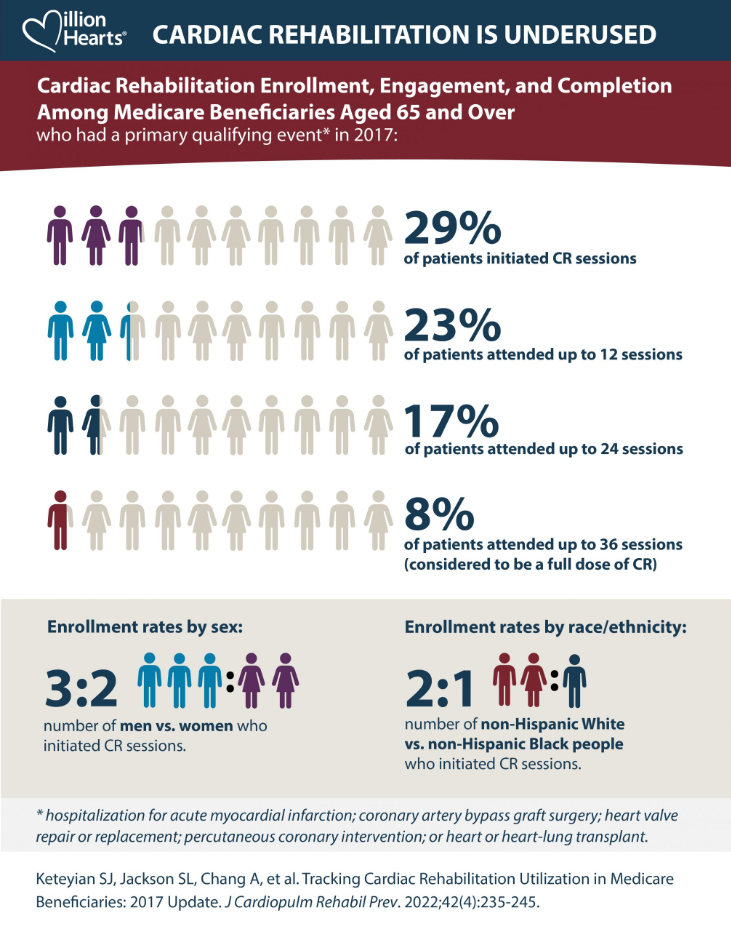
According to the CDC, about 800,000 people in the United States have a heart attack every year. About 1 in 4 of those people already had a heart attack. Cardiac rehabilitation is a medically supervised program designed to improve an individual’s cardiovascular health. Cardiac rehabilitation not only can help a person recover from a heart problem, but can also prevent future heart problems.
Strong evidence shows that cardiac rehab programs can benefit individuals who have:
- Had a heart attack
- Stable angina
- Received a stent or angioplasty
- Heart failure with reduced ejection fraction
- Undergone a bypass, valve or heart or heart-lung transplant surgery
Unfortunately, many individuals do not utilize cardiac rehabilitation in their journey to improved cardiovascular health. The Million Hearts® Campaign created an infographic, Cardiac Rehabilitation is Underused, which provides a clear depiction of the problem. The graphic details cardiac rehabilitation enrollment, engagement and completion of Medicare Beneficiaries (aged 65+) who had a primary *qualifying event in 2017.
- 29% of patients initiated Cardiac Rehabilitation (CR) sessions
- 23% of patients attended up to 12 sessions
- 17% of patients attended up to 24 sessions
- 8% of patients attended up to 36 sessions (considered to be a full dose of CR)
- Enrollment rates by sex: 3 men to 2 women initiated CR sessions
- Enrollment rates by race/ethnicity: 2 non-Hispanic White people to 1 non-Hispanic Black person initiated CR sessions
Older adults are also less likely to join a cardiac rehabilitation program following a heart problem. They may think they are unable to do the physical activity because of their age or they may have other conditions that can make exercising harder, such as arthritis. The need to address other physical conditions makes cardiac rehabilitation especially useful for older adults, since it can improve strength and mobility to make daily tasks easier.1
The Million Hearts® Program developed the Cardiac Rehabilitation Change Package (CRCP) to help quality improvement teams from hospitals and cardiac rehab programs implement systems and strategies that target improved care for more patients eligible for cardiac rehab. The second edition of the Change Package was published in 2023 and includes new change concepts, change ideas, and twice as many tools and resources that reflect the latest evidence and experience of hospitals, cardiac rehab programs and national organizations and quality improvement organizations.
Specifically, the second edition of the CRCP includes new content to:
- Communicate the opportunity for improvement to hospital leadership
- Access and use data to drive improvement
- Develop new CR program staffing models
- Implement automatic “opt out” referrals with care coordination (largely generated from the Agency for Healthcare Research and Quality’s TAKEheart initiative),
- Increase CR participation among people from demographic groups historically underrepresented among CR participants
- Advance hybrid CR delivery models
Sources:
- Schopfer DW, Forman DE. Cardiac rehabilitation in older adults. Can J Cardiol 2016;32(9):1088–1096.
- Infographic Source: Keteyian SJ, Jackson SL, Chang A, et al. Tracking Cardiac Rehabilitation Utilization in Medicare
- Beneficiaries: 2017 Update. J Cardiopulm Rehabil Prev. 2022;42(4):235-245.

Listen to our podcast, Q-Tips For Your Ears!
Cardiac Rehab: Do It For Your Heart: Following a diagnosis of heart attack or heart failure, or after a procedure such as a heart stent or heart surgery, participating in cardiac rehab is one of the best things you can do for your heart.

